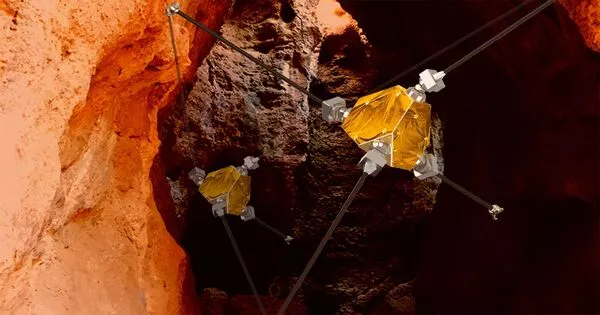Caves have provided shelter for prehistoric humans for millennia. Caves have also piqued the interest of academics ranging from early Chinese naturalists to Charles Darwin. A cave ecologist has been in and out of these subterranean ecosystems, studying the unique life forms and unique living conditions that exist in Earth’s many caves. But what does this mean for caves on other planets? Engineers, astrophysicists, astrobiologists, and astronauts lay out the research that needs to be done to get us closer to answering the age-old question about life beyond Earth in two linked studies.
Is there life in Martian caves?
It’s an interesting question, but it’s not the right one just yet. An international scientific collaboration led by NAU researcher Jut Wynne has dozens of questions that need to be asked and answered. We can return to that question once we figure out how to study caves on the Moon, Mars, and other planetary bodies.
Wynne, an assistant research professor of cave ecology, is the lead author of two related studies, both of which were published in the Journal of Geophysical Research Planets in a special collection of papers on planetary caves. The first, “Fundamental Science and Engineering Questions in Planetary Cave Research,” was completed by an interdisciplinary team of 31 scientists, engineers, and astronauts who generated a list of 198 questions that they narrowed down to the 53 most important after consulting with another 82 space and cave scientists and engineers.
This is the first study to identify research and engineering priorities to advance the study of planetary caves, drawing on the knowledge of a large portion of the space science community. The team hopes their work will inform what will ultimately be needed to support robotic and human missions to a planetary cave – namely on the Moon and/or Mars.
With the necessary financial investment and institutional support, the necessary advancements in research and technological development over the next decade are attainable. We now have two foundational papers that I hope will help propel planetary cave research from an armchair contemplative exercise to robots probing planetary subsurfaces.
Wynne
The first study inspired the second, “Planetary Caves: A Solar System View of Products and Processes.” Wynne discovered that no effort had been made to catalog planetary caves throughout the solar system, which is another critical piece of the big-picture puzzle. He gathered a new team of planetary scientists to investigate that question.
“With the necessary financial investment and institutional support, the necessary advancements in research and technological development over the next decade are attainable,” Wynne said. “We now have two foundational papers that I hope will help propel planetary cave research from an armchair contemplative exercise to robots probing planetary subsurfaces.”
What we know about extraterrestrial caves
There are a lot of them. Scientists have identified at least 3,545 potential caves on 11 different moons and planets throughout the solar system, including the Moon, Mars, and moons of Jupiter and Saturn. Cave formation processes have even been identified on comets and asteroids. If the surrounding environment allows for access into the subsurface, that presents an opportunity for scientific discovery that’s never been available before.
The discoveries in these caves could be massive. Caves may one day allow scientists to “peer into the depths” of these rocky and icy bodies, which will provide insights into how they were formed (but also can provide further insights into how Earth was formed). They could also, of course, hold secrets of life.

“Caves on many planetary surfaces represent one of the best environments to look for evidence of extinct or possibly extant lifeforms,” Wynne explained. “For example, because Martian caves are protected from lethal surface radiation and violent windstorms, they are more likely to have a more consistent temperature regime than the surface, and some may even contain water ice. As a result, caves on Mars have become one of the most important exploration targets in the search for life.”
These same factors make caves suitable locations for astronaut shelters on Mars and the Moon when crewed missions are able to explore.
“Radiation shielding will be essential for human exploration of the Moon and Mars,” said Leroy Chiao, a retired astronaut, former commander of the International Space Station, and co-author of the first paper. “One possible solution is to utilize caves for this purpose. The requirements for astronaut habitats, EVA suits, and equipment should take cave exploration and development into consideration, for protection from both solar and galactic cosmic radiation.”
What Earth can tell us about other planets
Wynne, whose primary research is in terrestrial caves, said planetary cave research has long been a parallel research question to the earthly variety for nearly two decades. Caves support unique ecosystems that are sometimes quite divorced from the surface ecosystem in the same area. Who’s to say a cave on the Moon or Mars would not be similar? So, many questions he’s investigated about caves on Earth, he’s wondered how it could apply on other planets.
He isn’t the only one who sees the connection. Wynne has worked on numerous research projects with NASA to advance detection technologies, and his modeling of cave habitats is unconcerned about whether a cave is terrestrial or extraterrestrial. There are enough similarities in the cave environment to make reasonable predictions, which will be used to select cave targets for exploration.
“Tellurian caves at depth are frequently characterized by complete darkness, a stable temperature close to the average annual surface temperature, little to no airflow, and a near-water-saturated atmosphere,” he explained. “The caves of other planetary bodies will most likely have similar environmental conditions, but these will also be influenced by the planetary body’s surface conditions and the internal structure of the cave.”
Keith Cowing, an editor of SpaceRef.com and NASAWatch.com, believes that using a planet’s surface and subsurface infrastructure may allow humans to reach other planets sooner than if we had to bring everything we needed to survive with us.
“For hundreds of thousands of years, humans have lived in caves. When none were available, they built their own” He stated. “As a result, it is natural to assume that caves will serve a similar purpose as humanity expands to other worlds. While planet-wide terraforming may be the ultimate goal, using large, pre-existing structures like caves and lava tubes may be a more practical way to get the technology to the maturity required to tackle the surface of an entire planet.”
















